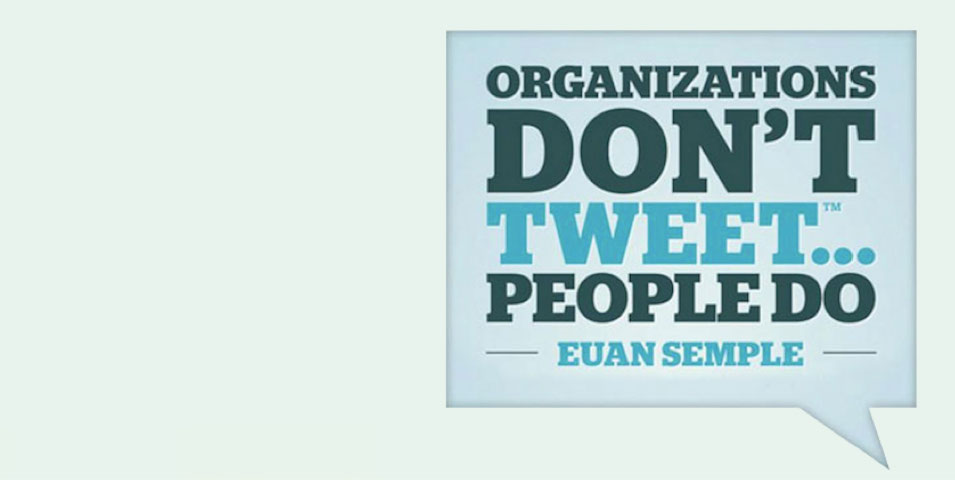
Before social media was known as social media, there was Euan Semple and the transformational work he did at the BBC with online tools that allowed people in disparate locations to communicate, share knowledge and learn from one another. Since his time at the Beeb, Euan has authored a book Organizations Don’t Tweet, People Do and worked with leaders of organisations as diverse as Nokia, BUPA, NATO, Ernst & Young, BP and the World Bank.
In November, Ellis Jones hosted two workshops at Melbourne’s Wheeler Centre to provide an understanding of how social media is shaping business today, and will into the future.
With a thick and friendly Scottish accent, Euan talked to us and not at us, ably assisted by his long time collaborator and Ellis Jones director online engagement, Kate Crawshaw.
Euan believes the web is a networked, organic structure. We’ve formed a new hierarchy online based on being interesting and interested, and connecting using something useful and relevant to our audience.
Online tools allow “globally distributed, near instant, person-to-person conversations.” – as predicted over ten years ago by the seminal publication, The Cluetrain Manifesto.
Social media was first regarded as the web but the name has now been lassoed and ridden in the direction of social media ‘marketing’. The result is immense energy being put into social media platforms for reaching customers – primarily friends’ networks (like Facebook and Twitter) and marketing pages and activity.
But so much of what Euan found so effective at the BBC has not been broadly adopted despite its promise. Euan attests that social media can reduce business operating costs by 30% when used internally.
The first type of social media at the BBC was the humble internal bulletin board. It encouraged BBC staff to submit questions for answering by other staff, and to share information. Steadily, people embraced the bulletin board, often helping other colleagues across the network who had similar questions. Sometimes the information provided was incorrect, but this benefited senior management in identifying misconceptions, system or process failure and cultural issues within the organisation in order to make improvements. Often in community ‘management’ the best rule is to step back and let the network take care of itself.
Externally, organisations can use social media to directly work with key stakeholders. Some examples include:
- Fix My Street allows people to engage their council about local issues such as graffiti and broken paving.
- GiffGaff is a mobile telecommunications company which works in collaboration with its members, crowd-sourcing customer service. Customers can select to get customer support from one another for a reduced service rate. A wonderful example of where actions and behaviour is a foundation for brand communication, not marketing messages.
- Local Motors uses a network of 10,000 engineers and designers to bid for best crowd-sourced car design brief. The power to build your dream car is in your hands.
Further simple, yet powerful messages included:
Trust.
Social media is about relationships. In offline relationships, it is rare to have an association with a person you don’t trust. The very same applies to your online relationships with people, brands and companies. Become a trusted resource, social media channels facilitate two way dialogue and anything contrary to that falls in the spam category. Be human.
Giving specialists and experts a voice that accrues to your brand builds trust in the organisation; a credible point of difference, resulting in content that ‘lives’. If people trust what you’re saying, they are more likely to share your content.
Reciprocity.
In order to gain people’s trust online, you need mass reciprocity to connect. The more you give out, the more you get back. But you need to be sensitive about what you share. The role of content curation on the web is becoming very interesting and demonstrates that showing or sharing content that is relevant – rather than producing it all – establishes you as a trusted resource that is willing to give back. Put simply, sharing is caring.
“Ooh that’s interesting…”
Produce enticing content that makes people go “ooh that’s interesting”. Don’t blame the reader for low engagement. You can’t force people to read articles and bits of information in this environment, you have to entice them. If you want lots of people to read your content, you need to write standout material that is read and shared by smart people.
Watching and listening.
There is a term for those who simply sit back and observe what others are saying or doing online. That term is “lurking” and you can learn a lot from doing it. Learn how people write, who they link to and what they write. Like all good practice, spend more time with your ears open rather than your mouth (or at least fingers).
Blogging.
Blogs are an individual’s ideas, dispersed and easily linked to. You can write a blog piece and refer to it via other platforms (ie: Twitter). Blogging presents an identity, an individual, a person. Good blog posts link out to other good blog posts, connecting trains of thinking. By creating a personal blog, others can easily link to your content and you can become a trusted source of information in your area of expertise or interest. Blogging gives many leaders an outlet to reflect, sense interest and become more observant.
Starting from the inside out.
Organisations are generally driven to use social media with external stakeholders first. Building internally communication capacity first with these tools allows organisations to build strong communication networks to ensure the organisation is ready to respond to the challenges of the outside world.

